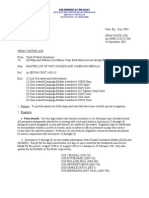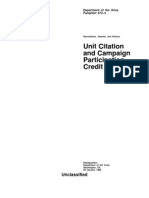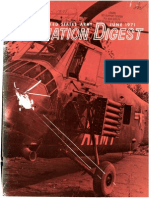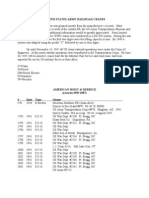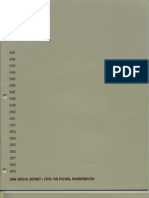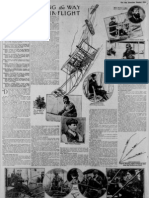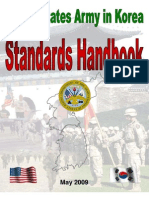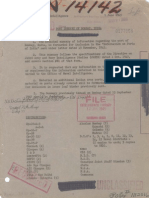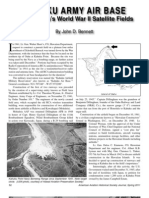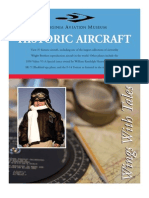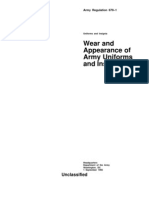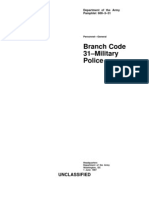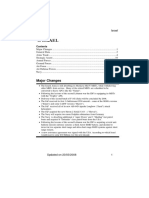Evolution of Naval Wings PDF
Evolution of Naval Wings PDF
Uploaded by
Mack OaxtonCopyright:
Available Formats
Evolution of Naval Wings PDF
Evolution of Naval Wings PDF
Uploaded by
Mack OaxtonOriginal Title
Copyright
Available Formats
Share this document
Did you find this document useful?
Is this content inappropriate?
Copyright:
Available Formats
Evolution of Naval Wings PDF
Evolution of Naval Wings PDF
Uploaded by
Mack OaxtonCopyright:
Available Formats
UNITED STATES NAVAL AVIATION 19101995
APPENDIX
655
20
Evolution of Naval Wings
(Breast Insignia)
Naval Aviator Wings
he origin of a distinctive device for Naval Aviators
is somewhat obscure, but the idea was undoubtedly
influenced by outside forces. It appears that the need
for a distinguishing mark was voiced by the aviators
themselves, particularly after Army aviators began
wearing badges in 1913. Other influence outside the
naval service also appears to have provided some of
the initial impetus.
A review of the records indicates a lack of coordination within the Navy during the process to develop a
Naval Aviation device. The dated correspondence of
the Bureau of Navigation (BuNav) and the Chief of
Naval Operations (CNO) Aviation Section relating to
the wings does not coincide with the dated changes
to the Uniform Regulations. The change to the
Uniform Regulations that first identified the new
wings was issued before the CNOs Aviation Section
and BuNav had agreed upon a final design. Several
separate evolutions occurred in 1917.
A 29 June 1917 letter from the G. F. Hemsley Co.,
stating that the sender takes the liberty of forwarding
a design for an aviation cap and collar ornament, may
well have started official action. The first official correspondence on the subject appears to have been a
CNO letter to BuNav dated 19 July 1917. This letter,
which forwarded a suggestion from the G. F. Hemsley
Co. for aviator cap and collar ornaments, rejected the
ornaments but went on to say that since foreign countries and the U.S. Army had adopted an aviation device, Naval Aviators also should be given some form
of mark or badge to indicate their qualification, in
order that they have standing with other aviation services. The letter, prepared in the Aviation Section of
CNO, enclosed a representative design for wings.
From that date, the subject was kept alive by the exchange of correspondence concerning the design and
production of the insignia by interested firms.
Lieutenant Commander John H. Towers, assigned to
the aviation desk under CNO, requested the assistance
of Lieutenant Henry Reuterdahl in designing the Naval
Aviator wings. Reuterdahl played an important part in
the design development. He was later assigned as an
artist to record the first transatlantic flight in May 1919,
which was originally planned to be made by four NC
aircraft. (Only one, the NC-4, completed the crossing
arriving in Plymouth, England, on 31 May.) In a 28
September 1917 letter to Bailey, Banks, and Biddle
Company, he recommended simplifying the wings by
bolder chasing (engraving) and a reduction in the number of feathers, noting that most naval ornaments are
too fine and not broad enough in character. He also
recommended changes in the anchor and rope and the
introduction of a slight curve to conform to the shape
of the body. He summarized his remarks by saying, My
idea has been to reduce all corners so that there will be
no points which might catch in the clothing.
Several different designs were proposed and submitted for approval. The sample pins passed through a
number of changes. Bronze, the first metal proposed,
was quickly rejected in favor of a gold and silver combination. This, in turn, was changed to all silver and finally, in October 1917, all gold was selected. The size
changed from over three inches to the final of 234
inches. The U.S. was dropped from the design and
stars on the shield were proposed and rejected as violating the laws of heraldry.
By October 1917 the Bailey, Banks, and Biddle
Company took the lead over its competitors and on 24
October submitted its first sample pin. In early
November it submitted other samples and was ready
to make prompt delivery of such number of devices
as you may desire. It is believed these various sample
pins added to the confusion regarding the existence of
official Naval Aviator wings. On the final decision to
place an order, the record is obscure but it may have
been a BuNav letter to the Supply Officer at NAS
Pensacola, Fla., dated 21 November 1917, selecting
the higher priced pin ($1.15 each). The company
was not named, but it seems fairly certain that it was
Bailey, Banks and Biddle. Its letter to BuNav dated 19
December 1917 confirms a telegram stating: balance
aviator insignia shipped tomorrow.
The first Wings, made by Bailey, Banks, and Biddle
of Philadelphia, Pa., were received by the Navy in
655
656
UNITED STATES NAVAL AVIATION 19101995
December 1917 and issued early in the following year.
The fact that the first pins were delivered in this
month is also confirmed in a 26 December letter from
BuNav to NAS Pensacola reporting that the new pins
had been received and will be sent out as soon as
they can be engraved to show the Aviators number,
his name and branch of service. The Bureau asked
the jeweler not to sell the wings to individuals.
The requirement to engrave the aviators number
posed a problem concerning the precedence list of
trained naval aviators. This was solved by the preparation of an aviators precedence list, covering numbers
1 through 282, by the CNO Aviation Section. Thus, the
development of wings was responsible for the first
precedence list and, in addition, was a factor in the
later assignment of fractional numbers to many aviators omitted from this first compilation.
When forwarded to BuNav on 19 January 1918, distribution of the first wings could begin. After almost
eight years of Naval Aviation and nine months of war,
Naval Aviators had wingsa badge of qualification that
would set them apart. It seems likely that Commander
Towers, senior Naval Aviator in Washington at the time,
was an earlyif not the earliestrecipient. The engraving of the individuals name, Naval Aviator number, and branch of service was discontinued sometime
during World War I.
The official approval for Naval Aviator wings was
announced before a final design had been agreed
upon. On 7 September 1917, the Secretary of the Navy
approved Change 12 to the 1913 Uniform Regulations.
The pertinent portion read: A Naval Aviators device,
a winged foul anchor with the letters U.S., is hereby
adopted to be worn by qualified Naval Aviators. This
device will be issued by the Bureau of Navigation
(BuNav) to officers and men of the Navy and Marine
Corps who qualify as Naval Aviators, and will be worn
on the left breast.
However, before any such wings were issued, the
design was modified by Change 14, approved 12
October 1917 and issued in BuNav Circular Letter 4017 of 20 November 1917: The device for Naval
Aviators will be a winged foul anchor, but the letters
U.S. given in Change in Uniform Regulations No. 12,
have been omitted. Several other changes to the 1913
Uniform Regulations occurred regarding the Naval
This design, published in the Air Service Journal, was
never issued as the Naval Aviator wing insignia.
Aviator wings before the design was finalized. Uniform
Regulations, Change Number 18 of 1 April 1918, states
Naval Aviators Device-Device for naval aviators will
be a winged foul anchor, to be worn by qualified
naval aviators. This device will be issued . . . and worn
on the left breast. Change number 20 (undated) has
the following pertinent information: Chapter 10 and
changes 11, 12, 14, 16, and 18 of Uniform Regulations,
1913, are annulled and in lieu thereof this chapter is
substituted: NAVAL AVIATORS DEVICE-Device for
naval aviators will be a winged foul anchor, to be
worn by qualified naval aviators. This device will be
issued by the Bureau of Navigation to officers and
men of the Navy and Marine Corps who qualify as
naval aviators, and will be worn on the left breast.
Another modification to the 1913 Uniform Regulation
was made by Change 29, dated 13 May 1920. In
Article 262, under Naval Aviators Device the title of
the paragraph was changed to read Naval Aviation
Insignia and the first sentence read: Insignia to be
worn by qualified naval aviators and by warrant officers and enlisted men holding certificate of qualification as naval aviation pilots, is a winged foul anchor.
The 1922 Uniform Regulations, approved on 20
September 1922, described the Naval Aviator wing design in more detail: A gold embroidered or bronze
gold-plated metal pin, winged, foul anchor surcharged
with a shield 12 inch in height, 234 inches from tip to tip
of wings; length of foul anchor 1 inch. Except for a
reduction in the length of the foul anchor from 1 to 78
inch, made by Change 1 to the above Regulations, and
an elaboration of the description in 1951 which added
dimensions for the shield (7 16 inch high and at its
widest point) and for the width of the anchor (1116 inch
at the flukes and 716 at the stock), the original design
has changed very little since 1922.
The design pictured below was published by the Air
Service Journal on 27 September 1917. A short article
in the Journal identified it as a Naval Aviators Device
of gold and silver metal as described by a Change in
Uniform Regulations No. 10. It is believed the article
may have been referring to Change 12 in the Uniform
Regulations which was issued on 7 September 1917.
This published design, most likely an artist rendition,
also failed to take into account the shield.
UNITED STATES NAVAL AVIATION 19101995
The following artist rendition is most likely the design referenced in Change 12 of Uniform Regulations,
1913, and issued on 7 September 1917.
657
During World War II Naval Aviator wings began
showing a series of dots, or circles in the upper-part of
the design where the wings break. The original design
shows these as small feathers, not dots or circles.
This contemporary artist rendition was never issued as the Naval
Aviator wing insignia.
The photograph below is of the original design authorized by Change 14 of the 1913 Uniform
Regulations, approved 12 October 1917, and quoted
in BuNav Circular Letter 40-17 of 20 November 1917.
This is the officially approved design made by Bailey,
Banks and Biddle and issued to Naval Aviators in
early 1918.
This photograph shows the dots or circles in the upper-part of wing.
On most of the Naval Aviator wings there is a small
dot or circle on one of the anchor flues. That design
is part of the normal structure of an anchor and is
called a becket. A becket is an eye with a line attached used for securing the anchor to the side of the
ship to keep it from moving when the ship is underway.
Original wings issued to Naval Aviators.
The following photographs trace the evolution of
the Naval Aviator wings during the 1920s, 1930s and
early 1940s:
This photograph shows the wing design, in gold or a gold finish, that
has been the standard design since the 1950s.
Aircrew (Air Crew)/Combat Aircrew
Wing Insignia
This photograph shows the highly detailed design used during the
1920s and 1930s.
This photograph shows a curved shield design used in the 1930s and
1940s.
During World War II a new aviation breast insignia
was designed in response to numerous recommendations from the Fleet to recognize the job done by enlisted aircrew personnel flying in combat. In a Navy
Department press release of 18 May 1943, the new Air
Crew Insignia was described as follows: The Air Crew
insignia consists of silver wings with a center disk surcharged with fouled anchor. Below the disk is a scroll
with the legend Air Crew, and above it is a bar on
which gold stars can be placed.
The Bureau of Naval Personnel (BuPers) Circular
Letter Number 90-43 of 29 May 1943 announced the
approval of an Air Crew Insignia, recognizing the airfighting ability of flight crews. The insignia was intended primarily for enlisted ratings in the flight crews
of naval aircraft. However, any commissioned or warrant officer, other than pilots or designated naval aviation observers, who met the qualification require-
658
UNITED STATES NAVAL AVIATION 19101995
ments, were eligible to wear the insignia. The initial
requirements for insignia were:
a. Having served, subsequent to 7 December 1941,
for a total of three months as a regularly assigned
member of the Air Crew of a combatant craft.
(1) Combat aircraft shall be considered as all
operating aircraft of the Fleet or Frontier
Forces, and excepts utility aircraft which are
neither designed nor fitted out for offensive
(or defensive) operations.
(2) The term regularly assigned member of the
Air Crew shall be interpreted literally, and
shall be substantiated by the battle station bill
of the unit, under such instructions that may
be approved and promulgated by the Bureau
of Naval Personnel.
b. Having suffered injuries or other physical impairment, while engaged in combatant operations since 7
December 1941, as a regularly assigned member of a
combatant aircraft, which precludes the possibility of
fulfillment of the time requirements, stated in subparagraph (a) above, and is recommended by the
Commanding Officer of the Unit in which injury or
physical impairment was received.
c. Individual combat stars will be authorized by Unit
Commanders, in conformance with instructions issued
by Commander-in-Chief, United States Fleet, to those
members of Air Crews who:
(1) Engage enemy aircraft, singly or in formation.
(2) Engage armed enemy combatant vessels with
bombs, torpedoes, or machine guns.
(3) Engage in bombing offensive operations
against enemy fortified positions.
(4) A maximum of three combat stars shall be
awarded for display on the Air Crew Insignia;
combat actions reports in excess of three will
be credited only in the record of the individual concerned.
d. Personnel qualified by provisions of subparagraphs (a) and (b) above may wear the Air Crew
Insignia permanently.
The above set of requirements for qualification to
wear the Air Crew Insignia were modified several
times. BuPers Circular Letter Numbers 173-43 of 8
September 1943, 22-44 of 29 January 1944 and 174-44
of 16 June 1944 all make modifications to the qualifications but do not give a detailed description of the
insignia.
BuPers Circular Letter Number 395-44, dated 30
December 1944, provided a comprehensive description of the Aircrew Insignia: The Aircrew Insignia is a
silver-plated or silver-color, winged, metal, pin, with
gold-color circular shield with surcharged foul anchor,
superimposed on wing roots, with words AIRCREW
below circular shield; a silver-color bar over the circu-
lar shield with three threaded holes to receive three
gold-color combat stars when officially awarded. The
insignia will measure two inches from tip to tip of the
wings: circle on shield 5160; total depth of the shield
from the top of the circle to the bottom of the shield
9
160. The Uniform Regulations of 2 May 1947 provided
the following description of the Aircrew wings: A silver-plated or silver color, winged, metal pin, with gold
circular shield surcharged with foul anchor, superimposed on wing roots, with word AIRCREW in raised
letters on a silver-color background below the circular
shield; above the shield there shall be a silver-color
scroll; the insignia to measure 20 from tip to tip of the
wings; circle on shield 5160 in diameter; total height of
the shield and silver background beneath the shield
9
160. The scroll shall be 180 wide and 340 long and shall
be centered over the wings. Gold stars to a total of
three, as merited, shall be mounted on the scroll, necessary holes being pierced to receive them. A silver
star may be worn in lieu of three gold stars.
This line drawing depicts an early Aircrew Insignia that was published in the Naval Aviation News magazine in April 1943. It shows
the breast insignia without the stars.
In 1958 there was a major change in the Aircrew
Insignia. On 10 April 1958 Change 5 to the 1951
Uniform Regulations was issued. The name Aircrew or
Air Crew Insignia was redesignated Combat Aircrew
Insignia. Besides the redesignation, there were a few
minor changes to the breast insignia. The new description of the Combat Aircrew Insignia read: A silver
color, metal pin; winged, with gold color circular
shield surcharged with a foul anchor, superimposed
on wing roots; with word AIRCREW in raised letters
on a silver background below the shield. Above the
shield there shall be a silver color scroll. The insignia
shall measure 20 from tip to tip of wings; the circular
shield shall be 380 in diameter; height of anchor 140
with other dimensions proportionate; total height of
shield and silver background beneath 9160; the scroll
shall be 3 40 long and 1 40 wide; centered over the
shield, each end to rest on top of wings. Gold stars of
a size to be inscribed in a circle 180 in diameter, to a
total of three, as merited, shall be mounted on the
scroll, necessary holes being pierced to receive them.
UNITED STATES NAVAL AVIATION 19101995
659
A silver star may be worn in lieu of three gold stars.
Following the 1958 redesignation of the Air Crew insignia to Combat Aircrew Insignia, the Navy continued
to allow the wearing of the redesignated Combat
Aircrew Insignia for those Navy individuals who had
previously been authorized to wear the device.
The Aircrew Insignia approved in 1958.
The Combat Aircrew Insignia as depicted in the post-1958 time frame.
With the establishment of a separate Aircrew Wing
insignia the Navy no longer awarded or issued the
Combat Aircrew Wing Insignia. The 1978 U.S. Navy
Uniform Regulations removed the Combat Aircrew
insignia from the authorized list of aviation breast insignia. However, the Marine Corps continued to use
the Combat Aircrew Insignia and awarded the wings
to personnel who met the qualification requirements.
A Bureau of Naval Personnel Memorandum, approved by Chief of Naval Operations on 7 November
1994, authorized Navy personnel, who flew as aircrew with Marine Corps units in combat, to wear the
Combat Aircrew wings. However, the Combat
Aircrew wings are not authorized for Navy personnel
flying in combat aboard Navy aircraft. They are only
authorized to wear the Aircrew wings. The appropriate change was made to the Navy Uniform
Regulations.
Aircrew Insignia Wings
Change 5 to the 1951 Uniform Regulations, dated
10 April 1958, redesignated the Aircrew Insignia to
Combat Aircrew Insignia and also established a new
Aircrew Insignia. The new Aircrew Insignia was patterned along the basic lines of the Naval Aviation
Observer insignia. Description for the new Aircrew insignia was: Shall be a gold color metal pin; winged,
with a circular center design and anchor upon which
the block letters AC are superimposed. Width between tips of wings shall be 2340; circle diameter shall
be 340; height of anchor shall be 120 with other dimension proportionate.
On 11 August 1965, BuPers Notice 1020 authorized
the wearing of the Aircrew Breast Insignia on a permanent basis. From the establishment of the Aircrew
Insignia in 1958 and until 1965, the insignia could only
be worn by qualified personnel serving in an aircrew
position. If an individual was assigned to a shore billet
and not involved in aircrew duties, then they were not
authorized to wear the insignia. Under the new guidance, a person who qualified to wear the Aircrew
Insignia could continue to wear the breast device at
anytime during their military service or unless the person was disqualified for aircrew duty.
Naval Aviation Experimental Psychologists
and Naval Aviation Physiologists Wings
On 12 April 1967, the Under Secretary of the Navy
approved a change to the Navy Uniform Regulations
that authorized a new wing insignia for Aviation
Experimental Psychologists and Aviation Physiologists.
In February 1966, Aviation Experimental Psychologists
and Aviation Physiologists were designated as crew
members and ordered to duty involving flying. These
individuals were assigned to duties such as in-flight
analysis of human performance in fleet and training
operations covering a myriad of weapons systems and
tactics, providing extensive training for all aircrew
personnel in airborne protective equipment and
egress systems, and test and evaluation of new and
improved aircraft systems.
The gold wings of the Naval Aviation Experimental
Psychologists and Naval Aviation Physiologists are
similar to those worn by Flight Surgeons, except the
gold oak leaf does not have the acorn. The photo
below shows the wings of the Naval Aviation
Experimental Psychologists and Naval Aviation
Physiologists.
Photograph of Naval Aviation Experimental Psychologists and
Physiologists Wings.
660
UNITED STATES NAVAL AVIATION 19101995
Naval Aviation Supply Wings
Plans began in 1982 for the establishment of a Naval
Aviation Supply Officer Program and the authorization
for a breast insignia for qualifying Supply Corps officers. On 8 May 1984, during the 73rd annual Aviation
Ball, the first Naval Aviation Supply wings were presented by Vice Admiral Robert F. Schoultz, Deputy
Chief of Naval Operations (Air Warfare), to Vice
Admiral Eugene A. Grinstead, Jr., SC, USN; Rear
Admiral Andrew A. Giordano, SC, USN (Ret); and
Commodore John H. Ruehlin, SC, USN, Commanding
Officer, Aviation Supply Office, Philadelphia, Pa.
Officers qualified to wear the Naval Aviation Supply
wings must complete a demanding qualification program which required approximately 350 hours of
study and practical experience. They must also pass
an oral examination administered by supply and aviation maintenance officers at their operating sites.
The Naval Aviation Supply wings consist of the traditional Naval Aviator wing style with an oak leaf cluster in the center. The photograph below is a line
drawing depicting the wings.
Photograph of Naval Enlisted Aviation Warfare Specialist Wings.
Balloon Pilot Wing Insignia
The exact date the Balloon Pilot wing device was
approved is not clear. However, the description of the
wing first appeared in the 1922 Uniform Regulations
of 20 September 1922. In this Uniform Regulation the
following statement appears: Enlisted men holding
certificates of qualification as balloon pilots shall wear
the same insignia as in paragraph (a) but with the
right wing removed. Paragraph (a) was a description
of the Naval Aviator wings. There were no changes
between 1922 and 1947. In the 1947 Uniform
Regulations of 2 May 1947, the words Enlisted men
are replaced by Persons in the above statement. The
1978 U.S. Navy Uniform Regulations removed the
Balloon Pilot insignia from the authorized list of aviation breast insignia.
A line drawing of the Naval Aviation Supply Wings.
Enlisted Aviation Warfare
Specialist Wings
In order to recognize enlisted personnel serving in
Naval Aviation who were not aircrew members, a new
program and set of wings was established. The
Operational Navy Instruction (OPNAVINST) 1412.5 of
19 March 1980 established the Enlisted Aviation
Warfare Qualification Program and the new wing insignia. The Enlisted Aviation Warfare Specialist wings
are issued to enlisted personnel who acquired the specific professional skills, knowledge, and military experience that resulted in unique qualification for service
in the aviation activities of the Navy.
The 1981 Uniform Regulations described the
Aviation Warfare wings as follows: A silver embroidered or silver color metal pin (for enlisted); winged,
with a central device consisting of a shield with an anchor superimposed thereon and a scroll at the bottom
of the insignia.
This photograph shows the Balloon Pilot Wings used between 1922
and 1978.
Flight Nurse Wing Insignia
A BuPers Circular Letter Number 86-45 of 30 March
1945 announced the Secretary of the Navy had approved an insignia for naval flight nurses on 15 March
1945. The change to the 1941 Uniform Regulations
read as follows: Aviation Insignia, Naval Flight
NursesNurses who have been designated as Naval
Flight Nurses shall wear the following insignia: Goldplated metal pin, wings, with slightly convex oval crest
with appropriate embossed rounded edge and scroll.
The central device shall be surcharged with gold anchor, gold spread oak leaf and silver acorn, symbol of
the Nurse Corps insignia. The insignia shall measure 20
from tip to tip of the wings; oval crest 9160 in vertical
UNITED STATES NAVAL AVIATION 19101995
dimension and 7160 in width; oak leaf 13320 in length, 7320
in width, to be diagonally mounted surcharged on the
anchor; silver acorn 180 in length surmounted on oak
leaf. The insignia described above was to be worn
until the designation Flight Nurse was revoked.
On 11 August 1952, the Secretary of the Navy ap-
661
symbol of Medical Corps insignia. The metal pin
shall be of dull finish. Dimensions: 2 34 inches between wing tips, central device 1 inch in vertical dimension to lower edge of fringe. Lateral width of
oval crest, 34 inch. Oak leaf 78 inch in length, 916 inch
in width, to be vertically mounted surcharged on
oval. Silver acorn 38 inch in length surmounted on
oak leaf. A Navy Press Release issued a few days
earlier, on 27 July 1942, gave the following description: It will consist of wings which are a modification of the Perian Feroher with a central design consisting of convex oval crest with appropriate scroll
and rounded edge. The central device is to be surcharged with the gold leaf and silver acorn that
serves as the Medical Corps symbol.
This photograph shows the Flight Nurse Wings as approved in 1945.
proved a revision to the Flight Nurse Insignia. The
BuPers Change Memo 1-2 of 6 February 1953 described the new Flight Nurse Insignia as: The insignia
shall consist of a gold color metal pin of the same design as that prescribed for Flight Surgeons . . . except
that the acorn shall be omitted, and the width between wing tips shall be 20; oval width 15320 vertical
and 5160 horizontal axis; thickness at leaf center, 18.0
This line drawing depicts the Flight Surgeon Wings approved in 1942.
This line drawing depicts the Flight Nurse Wing Insignia that was approved in 1952.
Flight Surgeon Wing Insignia
On 18 May 1942, the Chief of Naval Personnel approved an insignia for Naval Flight Surgeons. A
BuPers Circular Letter Number 107-42 of 29 July
1942 announced changes to the 1941 Uniform
Regulations. These changes, as approved by the
Secretary of the Navy, included the establishment of
the new Flight Surgeon wings. The change to the
Uniform Regulations read as follows: Officers of the
Medical Corps who have qualified as Naval Flight
Surgeons shall wear the following insignia on the
left breast: A gold plated metal pin, winged, with
slightly convex oval crest, with appropriate embossed rounded edge and scroll. The central device
to be surcharged with gold oak leaf and silver acorn,
On 11 August 1952, the Secretary of the Navy approved a major revision to the Flight Surgeon wings.
The new design superimposed the Medical Corps device (gold oak leaf and silver acorn) on the style of
wings used for the Naval Aviator wing insignia.
BuPers Memo 1-2 of 6 February 1953 and the change
to the 1951 Uniform Regulations describes the new
design for Flight Surgeon wings as follows: A gold
embroidered or gold color metal pin; winged; with an
oval center design upon which the Medical Corps device (a gold oak leaf and silver acorn) is superimposed. Width between tips of wings shall be 2340; oval
with 580 vertical and 13320 horizontal axis; thickness
with acorn 3160; acorn and cup 7320 long; acorn width
1
80; cup depth 11160; cup width 11640.
This photograph shows the Flight Surgeon Wings that were approved
in 1952.
662
UNITED STATES NAVAL AVIATION 19101995
Naval Astronaut (Naval Flight Officer)
Wings
The 1984 Uniform Regulations, issued on 6 February
1984, authorized the wearing of the new Naval
Astronaut (Naval Flight Officer) wings. The regulations
described the wings as follows: Naval Astronaut
(NFO) Insignia. A gold embroidered or solid gold
metal pin; winged and containing a shooting star with
an elliptical ring surrounding the trailing shafts; superimposed diagonally from bottom right to top left, on
the shield of the traditional Naval Flight Officers
Wings.
A Naval Flight Officer or an active duty officer qualified as a Naval Astronaut (Specialist), who is not a
Navy pilot or NFO, may wear the Naval Astronaut
(NFO) Wings if they are designated by the CNO or
Commandant of the Marine Corps after meeting the
following qualifications:
a. Currently on flying status as a Naval Flight Officer
or a payload specialist as a shuttle astronaut (but not
qualified as a Navy Pilot or NFO) in either the Navy,
Marine Corps, or their Reserve components.
b. Trained, qualified, and certified to fly as a mission
or payload specialist in powered vehicles designed for
flight above 50 miles from the earths surface.
c. Have completed a minimum of one flight as a mission or payload specialist aboard an extraterrestrial vehicle in a flight above 50 miles from the earths surface.
The line drawing shows the Naval Astronaut (NFO) Wings.
Naval Astronaut (Pilot) Wings
The Navys first Naval Astronaut (Pilot) wings were
presented to Commander Alan B. Shepard, Jr., on 6
December 1961 by the Chief of Naval Operations
Admiral George W. Anderson. On 18 December 1962,
the Secretary of the Navy officially approved the
Uniform Boards recommendation to include a description and photograph of the Naval Astronaut wing
insignia in the 1959 Uniform Regulations. The Naval
Astronaut (Pilot) wings are identical to the Navy Pilot
wings with the addition of a shooting star superimposed over the shield. The shooting star symbolized
the astronauts spatial environment.
The Naval Military Personnel Manual states the criteria for designation as a Naval Astronaut (Pilot). A
Naval Pilot may wear the Naval Astronaut (Pilot)
wings upon designation by the CNO or Commandant
of the Marine Corps after meeting the following
qualifications:
a. Currently on flying status as a Naval Pilot in either
the Navy, Marine Corps, or their Reserve components.
b. Trained, qualified, and certified to fly a powered
vehicle designed for flight above 50 miles from the
earths surface.
c. Completed a minimum of one flight as a pilot or
mission specialist aboard an extraterrestrial vehicle in
a flight above 50 miles from the earths surface.
The photograph shows the Naval Astronaut (Pilot) Wings that were
first presented in 1961.
Naval Aviation Observer Wings
The Naval Aviation Observer (NAO) designation had
its origin in an act of Congress on 12 July 1921, which
created the Bureau of Aeronautics and provided that
its chief qualify within one year of his appointment as
an aircraft pilot or observer. The functions and qualifications for an observer were first defined on 27
March 1922; on 17 June of the same year, Rear
Admiral William A. Moffett became the first to qualify
for the designation as a Naval Aviation Observer.
The 1922 Uniform Regulations, approved 20
September, provided that officers designated as Naval
Aviation Observer wear the same insignia as that worn
by Naval Aviators, except with the right wing and
shield removed and an O superimposed on the foul
anchor.
The line drawing is the first Naval Aviation Observer Wing Insignia.
It was used by the Navy from 1922 to January 1927.
UNITED STATES NAVAL AVIATION 19101995
663
A 26 January 1927 change to the 1922 Uniform
Regulations (Change Number 3) modified the Naval
Aviation Observer design and changed it to the same
insignia worn by Naval Aviators except that it was to
be in silver.
The Naval Aviation Observer Wings showing the dots in the upperpart of the wing.
Between January 1927 and October 1929 the design of Naval
Aviation Observer Wings was the same as Naval Aviator Wings except the observer wings were silver, not gold like the Naval Aviator.
Bureau of Navigation Circular Letter 71-29 of 19
October 1929 (Change Number 7 to the 1922 Uniform
Regulations) directed another change to the Naval
Aviation Observer wings. This letter described the new
design as: ...an insignia the same as for naval aviators
as to gold wings, but that the central device shall be
an O circumscribing an erect plain anchor, both in
silver. The O and anchor to be in bold relief, the center of the O being filled in gold. The 1941 Uniform
Regulations, of 31 May 1941, repeated the previous
description and added dimensions as follows:
. . . outer diameter of O shall be 34 inch, inner diameter 916 inch. Height of anchor shall be 12 inch.
This photograph of Naval Aviation Observer Wings is the type that
has been used by the Navy between 1929 to 1968.
The Naval Aviation Observer wings made the same
transition that occurred to the Naval Aviator wings
during World War II. A change to the 1951 Uniform
Regulations, issued on 6 February 1953 as BuPers
Change Memorandum 1-2, directed the wing style
used by the Naval Aviator breast insignia be adopted
for the Naval Aviation Observer insignia. Hence, the
series of dots, or circles were incorporated into the
upper-part of the design where the wings break.
The following is a detailed description of the Naval
Aviation Observer wings from the Uniform Regulations
of 6 April 1959: A gold embroidered or gold color
metal pin, winged, with a central device consisting of
an O circumscribing an erect, plain anchor, both in
silver; the O and the anchor to be in bold relief, the
center of the O being filled with gold. The insignia
shall measure 2340 between wing tips; outer diameter
of O shall be 340; inner diameter of O shall be 9160;
height of anchor shall be 120 with other dimensions
proportionate.
In the 1950s and 1960s, the Naval Aviation Observer
wings were worn by officers who were Radar
Intercept Operators (RIOs), Bombardier/Navigators
(BNs), and Airborne Electronic Countermeasures
Operators (AECMs). They were also worn by enlisted
personnel who were qualified Navigators, Airborne
Electronic Countermeasures Operators, Airborne Radio
Operators, VG Jet Aircraft Flight Engineers and qualified Observers.
On 18 July 1968, the CNO approved a new qualification breast insignia for Navy and Marine Corps personnel designated as Naval Flight Officers (NFOs).
BuPers Notice 1020 of 24 August 1968 issued the
change to the Uniform Regulations (NavPers 15665)
for the new Naval Flight Officer wings: This new insignia will replace the Naval Aviation Observer insignia currently worn by Naval Flight Officers and will
be authorized for wear upon source availability. The
Naval Aviation Observer insignia will become obsolete
after 31 December 1968. This ended the old Naval
Aviation Observer wings for a short period of time.
However, they were destined for continued use by
Naval Aviation.
Naval Aviation Observer and Flight
Meteorologist Wings
On 21 May 1969, the CNO approved the use of the
Naval Aviation Observer wings for wear by Flight
Meteorologists and for those officers formerly entitled
but not selected as Naval Flight Officers. This change
was incorporated into the 1959 Uniform Regulations
by Bureau of Personnel Notice 1020 of 16 June 1969.
The 1969 Uniform Regulations, issued on 17
October 1969, did not mention the Flight
Meteorologist insignia. However, the 1975 Uniform
Regulations, which replaced the 1969 edition, listed
664
UNITED STATES NAVAL AVIATION 19101995
the Naval Aviation Observers and Flight Meteorologist
wings. The 1975 regulations states: Naval Aviation
Observer and Flight Meteorologist Insignia. A gold embroidered or gold color metal pin; winged, with a central device consisting of an O circumscribing an erect,
plan anchor, both in silver; the O and the anchor to be
in bold relief, the center of the O being filled with
gold. The embroidered device shall be on a background to match the color of the uniform on which
worn.
Qualifications to wear the Naval Aviation Observer
wings, the second oldest wings in the Navy, are outlined in the Naval Military Personnel Manual. Although
not aeronautically designated, the following types of
officers are authorized to wear NAO wings upon initial
qualification: Flight Meteorology and Oceanography
Officer; Special Evaluator (officers and warrant officers
from the cryptologic community); Aviation Operations
Limited Duty Officer (632X); Aviation Operations
Technicain Warrant Officer (732X); and other officers
assigned by the Chief of Naval Personnel to duty involving flying as technical observers and airborne
command post crew members.
The Marine Corps authorized the use of the old
Naval Aviation Observer wings for personnel completing the Naval Aviation Observer School at Marine
Corps Air Station New River. Qualified aerial observers
were to provide commanders with information of intelligence value not readily available from normal
ground sources regarding enemy forces; procure information concerning terrain, and to supplement operational information of friendly forces; direct supporting
fires for ground forces to include artillery, naval gunfire, and close air support; to perform utility and liaison missions as directed from an observation aircraft
and to advise commanders of ground units on matters
pertaining to aerial observation.
See the section on Naval Aviation Observer Wings
for a photograph of the device.
Naval Aviation Observer (Navigation)
Wings
BuPers Circular Letter 88-45 of 31 March 1945 announced the Secretary of the Navy had approved an
insignia for Naval Aviation Observers (Navigation) on
30 March 1945. It revised the 1941 Uniform
Regulations by adding the following: Officers designated as Naval Aviation Observers (Navigation) by the
Chief of Naval Personnel shall wear the following insignia: A gold-embroidered or bronze gold-plated
metal pin, winged, with silver center device superimposed upon crossed gold-color foul anchors. The centerpiece shall have superimposed upon it, in bold relief and in gold color, one gold disc with eight
intercardinal points of the compass; superimposed
upon this gold disc will be a second disc, in bold relief and in gold color, with four cardinal points and
four intercardinal points of the compass. The insignia
shall measure 2340 from tip to tip of wings; silver center device shall be approximately 15320 in diameter;
crossed foul anchors shall be of a size to be inscribed
in a circle 340 in diameter; the inner gold disc shall be
approximately 180 in diameter, and the outer gold disc
shall be approximately 140 in diameter. Naval Aviators
and Naval Aviation Observers will not wear the Naval
Aviation Observer (Navigation) insignia.
A Bureau of Naval Personnel letter dated 18 March
1947 abolished the Naval Aviation Observer
(Navigation) insignia and authorized all officers designated as Naval Aviation Observer (Navigation) to wear
the same insignia as that worn by Naval Aviation
Observers.
The photo shows the Naval Aviation Observer (Navigation) Wing insignia used by the Navy for the period 19451947.
Naval Aviation Observers (Radar)
Wings
The Secretary of the Navy approved the Naval
Aviation Observer (Radar) insignia on 29 August 1945.
BuPers Circular Letter Number 313-45 of 17 October
1945 announced the insignia and a subsequent change
was made to the 1941 Uniform Regulations. The letter
described the wings as follows: Naval Aviation
Observers (Radar) shall wear a gold embroidered or
bronze gold-platted metal pin, winged, with silver center device superimposed upon crossed gold-color foul
anchors. The center piece shall have superimposed
upon it, in bold relief and in gold color, a symbolic
radar manifestation. The insignia shall measure 2340
from tip to tip of wings; silver center device shall be
approximately 15320 in diameter; crossed foul anchors
shall be of a size to be inscribed in a circle 340 in diameter. Naval Aviation Observers (Radar) shall not wear
any other aviation breast insignia.
A Bureau of Naval Personnel letter dated 18 March
1947 abolished the Naval Aviation Observers (Radar)
insignia, and authorized all officers designated as
Naval Aviation Observers (Radar) to wear the same insignia prescribed for Naval Aviation Observers.
UNITED STATES NAVAL AVIATION 19101995
665
Naval Aviation Observer (Aerology)
The photograph shows the Naval Aviation Observers (Radar) Wing
insignia used by the Navy for the period 19451947.
Naval Aviation Observers (Tactical)
Wing
On 19 January 1946, the Secretary of the Navy approved the Naval Aviation Observers (Tactical) wings
for Navy and Marine Corps officers performing duty
as gunfire and artillery spotters and general liaison
operations. A BuPers Circular Letter Number 28-46 of
5 February 1946 changed the 1941 Uniform
Regulations to reflect that Naval Aviation Observers
(Tactical) would wear a device similar to the Naval
Aviation Observer (Navigation) insignia except the
centerpiece shall have two crossed guns superimposed upon it, in bold relief and in gold color. The
PuPers letter provided the following description:
Naval Aviation Observers (Tactical) shall wear a
gold embroidered or bronze gold-plated metal pin,
winged, with silver center device superimposed
upon crossed gold-color foul anchors. The center
piece shall have two crossed guns superimposed
upon it, in bold relief and in gold color. The insignia
shall measure 2 3 40 from tip to tip of wings; silver
center device shall be approximately 15320 in diameter; crossed foul anchors shall be of a size to be inscribed in a circle 340 in diameter and the crossed
guns shall be of a size to be inscribed in a circle 13320
in diameter.
A Bureau of Naval Personnel letter dated 18 March
1947 abolished the Naval Aviation Observers
(Tactical) insignia and authorized all officers designated as Naval Aviation Observers (Tactical) to wear
the same insignia prescribed for Naval Aviation
Observers.
The photograph shows the Naval Aviation Observers (Tactical) Wing
insignia used by the Navy for the period 19461947.
BuPers Circular Letter Number 87-47 of 15 May 1947
established the designation Naval Aviation Observer
(Aerology). Besides establishing the qualifications necessary to be designated a Naval Aviation Observer
(Aerology), the circular letter also stated the following:
Officers designated naval aviation observers (aerology) by the Chief of Naval Personnel will be authorized to wear the insignia already established for naval
aviation observers . . . BuPers letter (Pers-329-MEB
A2-3) of 24 February 1948 issued Change 1 to the 1947
Uniform Regulations and states: Naval Aviation
Observer Insignia. Officers who have been designated
as naval aviation observers, Naval Aviation Observers
(Aerology), Naval Aviation Observers (Navigation),
Naval Aviation Observers (Radar), or Naval Aviation
Observers (Tactical) by the Chief of Naval Personnel
shall wear the following insignia: A gold embroidered
or bronze gold-plated metal pin, winged, with a central device consisting of an O circumscribing an
erect, plan anchor, both in silver; the O and the anchor to be in bold relief, the center of the O being
filled with gold. The insignia shall measure 2340 between wing tips; the outer diameter of the O shall be
3
40, the inner diameter 9160; height of anchor shall be
1
20. The embroidered device shall be on a background
to match the color of the uniform. See the Naval
Aviation Observer Wing section for a photograph of
the Naval Aviation Observer Wing.
Naval Flight Officer Wings
On 8 February 1965, a change to Bureau of
Personnel Instruction 1210.4C authorized a new desigantor and name, Naval Flight Officer (NFO). The new
designator was appropriate for an unrestricted line officer, a member of the aeronautical organization . . .
who may fill any billet not requiring actual control
knoweldge of an aircraft. Eight subspecialties were
available at the time: bombardier, controller, electronic
countermeasures evaluator, navigator, interceptor, photographer-navigator, tactical coordinator and reconnaissance navigator. The new NFOs continued wearing the Naval Aviation Observer wings.
On 18 July 1968, the CNO approved a new qualification breast insignia for Navy and Marine Corps personnel designated as Naval Flight Officers (NFOs).
BuPers Notice 1020 of 24 August 1968 changed the
Uniform Regulations (NAVPers 15665). The notice
stated: This new insignia will replace the Naval
Aviation Observer insignia currently worn by Naval
Flight Officers and will be authorized for wear upon
source availability. The Naval Aviation Observer insignia will become obsolete after 31 December 1968.
In this change to the Uniform Regulations (NAVPERS
666
UNITED STATES NAVAL AVIATION 19101995
15665) all references to Naval Aviation Observers were
changed to Naval Flight Officer. Article 0157.2d. of the
Uniform Regulations read: Naval Flight Officer
Insignia. A gold embroidered or gold color metal pin;
winged, with a central device consisting of a shield superimposed on a set of small, crossed, fouled anchors.
The embroidered device shall be on a background to
match the color of the uniform on which worn.
The Naval Flight Officer wings were approved to
General qualifications for wearing the Navy and
Marine Corps Parachutist Wings were:
(1) Have previously qualified for the Basic Parachutist insignia by completing formal parachutist training at an Armed Services installation.
(2) Have completed a minimum of five additional
parachute jumps, under competent orders, with a
Navy or Marine Corps organization whose mission includes parachute jumping.
Once a person qualified for the Navy and Marine
Corps Parachutist insignia it will be worn in lieu of the
Basic Parachutist insignia.
The photograph shows the Naval Flight Officer wings approved in 1968.
keep pace with the changes to the designators and
new titles for personnel that had been designated
Naval Aviation Observers. Flight officers are more
closely aligned with pilots as opposed to meteorologists and other scientists. Also, the flying officer/crewmen were line officers who were allowed to compete
for and earn any command assignment for which they
qualify by demonstrated performance and ability, with
the exception of a billet that required actual control
knowledge of an aircraft. Hence, Naval Flight Officers
were line officers who could qualify for command of a
ship or carrier or commanding officer of a squadron
just like Naval Aviators.
Navy and Marine Corps Parachutist
Wing Insignia
BuPers Notice 1020 of 12 July 1963 issued information on a change to the 1959 Uniform Regulations
concerning the adoption of a new wing insignia for
Navy and Marine Corps Parachutists. This notice
stated: The old parachutist insignia . . . shall be renamed the Basic Parachutist Insignia in conformance
with the Army and Air Force nomenclature. The subject insignia shall be referred to as the Navy and
Marine Corps Parachutist Insignia. The description of
the insignia was as follows: A gold embroidered
(Navy only) or gold-colored metal pin, same as that
provided for Naval Aviators insignia, except that a
gold-colored open parachute shall be centered on the
wings vice the shield and foul anchor; width of the
wings from tip to tip shall be 2 3 40; width of the
parachute 1 2 0 at the widest part; length of the
parachute from top to bottom 13160.
The photograph shows the Navy and Marine Corps Parachutist insignia approved in 1963.
Basic Parachutist Wing Insignia
The first mention of a parachutist designation and
qualification badge is found in a change to the 1941
Uniform Regulations issued by a BuNav Circular Letter
Number 51-42 of 31 March 1942. The circular letter
stated: The following Parachute Regulations, having
been approved by the Secretary of the Navy on 6
February 1942, are published herewith for the information of all concerned:
1. (2) DESIGNATION: The designation (ratings) of
Parachutist and Student Parachutist are hereby established for officers, warrant officers, and enlisted men
of the Navy and Marine Corps of the United States,
which designations (ratings) shall be in addition to
such military or Naval ratings or ranks as are now or
may hereafter be authorized by law.
(5) RETENTION OF DESIGNATION AS PARACHUTIST OR STUDENT PARACHUTIST: An officer,
warrant officer or enlisted man of the Navy . . . who
has attained a designation (rating) as a parachutist or
student parachutis . . . provided, that officers, warrant
officers, and enlisted men . . . who have been designated as parachutists pursuant to these regulations are
authorized to retain permanently and to wear such
qualification badge as parachutists as may be prescribed by competent authority.
However, the Secretary of the Navy did not authorize the parachutist badge, even though the above
change to the 1941 Uniform Regulation references the
wearing of such a qualification badge. There is no de-
UNITED STATES NAVAL AVIATION 19101995
scription of a parachutist insignia until January 1947. A
BuPers letter (Pers-329-MEB A2-3) of 17 January 1947
issued changes to the 1941 Uniform Regulations as approved by the Secretary of the Navy. This letter states:
(j) A parachutist insignia, enclosure (B), has been authorized for enlisted personnel who have been designated as parachutists in accordance with the Bureau of
Naval Personnel Manual. This insignia is the same as
the parachutist insignia authorized by the Marine
Corps and the Army. 2. The wearing of the parachutist
insignia, enclosure (B), by officers and warrant officers
who have been designated as parachutists in accordance with the Bureau of Naval Personnel Manual has
also been authorized. Pending a revision of Chapters
II and III, U.S. Navy Uniform Regulations, 1941, officers and warrant officers who are eligible to wear the
parachutist insignia may do so under similar regulations contained in Art. 8-8 of enclosure (A). A 14
February 1947 letter from BuPers issued the new
Chapter II to the 1941 Uniform Regulations and included the parachutist insignia.
The 1951 Uniform Regulations described the
Parachutist insignia as follows: An open parachute, in
silver, flanked on each side by wings, curved upward;
the device to be 1120 wide and 340 high. A BuPers
Notice 1020 of 12 July 1963 issued information on a
change to the 1959 Uniform Regulations concerning
the adoption of a new wing insignia for Navy and
Marine Corps Parachutists. This notice stated: The old
667
parachutist insignia . . . shall be renamed the Basic
Parachutist Insignia in conformance with the Army
and Air Force nomenclature.
Photograph of Basic Parachutist insignia.
Marine Aerial Navigator Wing
In June 1976, the Marine Corps approved the use of
the old World War II Naval Aviation Observer
(Navigation) wings for use by Marine Corps personnel
who qualified as Marine Aerial Navigators. See the section on Naval Aviation Observer (Navigation) wings
for a description and photograph of the wings.
Marine Aerial Observer Wing
See the section on Naval Aviation Observer and
Flight Meteorologist Wings. These are the wings worn
by Marine Aerial Observers.
668
UNITED STATES NAVAL AVIATION 19101995
A Bat missile on the wing
of a Navy Privateer, USN701606.
A Loon missile being launched from Carbonero (SS 337), USN-402800.
You might also like
- AAFC Badges of RankDocument1 pageAAFC Badges of RankTheRaypistNo ratings yet
- Ar 600-70 Army Writing ProgramDocument11 pagesAr 600-70 Army Writing ProgramMark Cheney100% (1)
- Air Force - May 2019 PDFDocument64 pagesAir Force - May 2019 PDFMarcello Assunção100% (5)
- 1965-66 Cruise Book VMCJ-1Document67 pages1965-66 Cruise Book VMCJ-1Jaroslav JochmanNo ratings yet
- Uniforms of The Wasp of WwiiDocument2 pagesUniforms of The Wasp of WwiifraignierNo ratings yet
- UNIF - Uniforms of The Royal Air ForceDocument8 pagesUNIF - Uniforms of The Royal Air ForceJean-pierre Negre100% (1)
- 1650Document852 pages1650Richard MorganNo ratings yet
- Uniform Regulations Oct1949Document15 pagesUniform Regulations Oct1949Jordan EdelsteinNo ratings yet
- Da Pam 672-3 - Unit Citation and Campaign RegisterDocument114 pagesDa Pam 672-3 - Unit Citation and Campaign RegisterMark CheneyNo ratings yet
- Army Aviation Digest - Jun 1971Document68 pagesArmy Aviation Digest - Jun 1971Aviation/Space History Library100% (2)
- Samson MK Ii PDFDocument2 pagesSamson MK Ii PDFAndrewScotson100% (1)
- WWII CAP Pilot Wings HistoryDocument2 pagesWWII CAP Pilot Wings HistoryCAP History Library100% (2)
- Cranes Us ArmyDocument21 pagesCranes Us ArmyNancyNo ratings yet
- Indiana Guard Reserve Uniforms (JFHQ-IGR Regulation 10-4)Document41 pagesIndiana Guard Reserve Uniforms (JFHQ-IGR Regulation 10-4)Herbert Hillary Booker 2ndNo ratings yet
- Squadrons 4Document2 pagesSquadrons 4ZZBDUNo ratings yet
- Aus Contribution To WW2Document10 pagesAus Contribution To WW2Adhithya SriniNo ratings yet
- Dress RegulationsDocument40 pagesDress RegulationsMilton Keynes Air CadetsNo ratings yet
- CAP Uniform Changes Memo - 03/12/2012Document10 pagesCAP Uniform Changes Memo - 03/12/2012CAP History LibraryNo ratings yet
- Squadron Book - 2018 Dubbel CardDocument82 pagesSquadron Book - 2018 Dubbel CardAnonymous opf1scDNo ratings yet
- Army Aviation Digest - Sep 1962Document52 pagesArmy Aviation Digest - Sep 1962Aviation/Space History LibraryNo ratings yet
- CAP Lineage & Command HistoryDocument4 pagesCAP Lineage & Command HistoryCAP History LibraryNo ratings yet
- Asdf 600-8-22Document19 pagesAsdf 600-8-22Mark CheneyNo ratings yet
- US Navy Aircraft Identification Colors Before World War IIDocument2 pagesUS Navy Aircraft Identification Colors Before World War IIRichard LundNo ratings yet
- The Pakistan NavyDocument12 pagesThe Pakistan NavyJhangir Awan0% (1)
- Michael Walker - Navy - MilDocument52 pagesMichael Walker - Navy - MilCristyBalanNo ratings yet
- 27th FS A History of FirstsDocument4 pages27th FS A History of FirstsMarc Matthew CzyganNo ratings yet
- California Wing - Jun 1990Document48 pagesCalifornia Wing - Jun 1990CAP History LibraryNo ratings yet
- Air Force Insignia Guide (2001)Document4 pagesAir Force Insignia Guide (2001)CAP History Library100% (1)
- 926 Engineer Aviation Regiment - September 6 1945Document88 pages926 Engineer Aviation Regiment - September 6 1945josé delmoteNo ratings yet
- Coastal Patrol Base 2 HistoryDocument15 pagesCoastal Patrol Base 2 HistoryCAP History LibraryNo ratings yet
- List of Air ForceDocument50 pagesList of Air ForceWeiz Shahzad Kalia100% (2)
- Flying The Flag': Mapping IAL & Boac RoutesDocument7 pagesFlying The Flag': Mapping IAL & Boac RoutesDave Fagan100% (1)
- Foulois and The U.S. Army Air Corps, 1931-1935Document363 pagesFoulois and The U.S. Army Air Corps, 1931-1935Bob Andrepont100% (1)
- 2009 Ribbons PosterDocument1 page2009 Ribbons Posterapi-241439984No ratings yet
- National HQ - 1960Document28 pagesNational HQ - 1960CAP History LibraryNo ratings yet
- Early Aviation Fatalities (1910)Document1 pageEarly Aviation Fatalities (1910)CAP History LibraryNo ratings yet
- CMH - Pub - 10-18 Signal Corps - The Outcome PDFDocument739 pagesCMH - Pub - 10-18 Signal Corps - The Outcome PDFGavin Hardie100% (1)
- Buckley Air Force BaseDocument9 pagesBuckley Air Force BaseAryan KhannaNo ratings yet
- Fargo Air Museum Dec 2010Document16 pagesFargo Air Museum Dec 2010CAP History LibraryNo ratings yet
- RAF Historical Society Journal 46Document190 pagesRAF Historical Society Journal 46Bobbie CarletonNo ratings yet
- HandbookDocument139 pagesHandbookNoble S WolfeNo ratings yet
- WWII 1945 Bombay India ReportDocument91 pagesWWII 1945 Bombay India ReportCAP History Library100% (2)
- CAP Patches HistoryDocument2 pagesCAP Patches HistoryCAP History Library100% (2)
- Kahuku Army Air BaseDocument10 pagesKahuku Army Air BaseCAP History LibraryNo ratings yet
- Army Aviation Digest - Nov 1989Document68 pagesArmy Aviation Digest - Nov 1989Aviation/Space History LibraryNo ratings yet
- Uniform Regulations USN 1913Document108 pagesUniform Regulations USN 1913堤 明夫100% (2)
- Army Aviation Digest - Apr 1972Document68 pagesArmy Aviation Digest - Apr 1972Aviation/Space History LibraryNo ratings yet
- Virginia Aviation Museum Jan 2012Document33 pagesVirginia Aviation Museum Jan 2012CAP History Library0% (1)
- Uniforms and Insignia: Wear and Appearance ofDocument248 pagesUniforms and Insignia: Wear and Appearance ofalexNo ratings yet
- Army Aviation Digest - Nov 1966Document52 pagesArmy Aviation Digest - Nov 1966Aviation/Space History Library100% (1)
- Ar670-1 Wear and Appearance of Army Uniforms and Insignia (1992)Document183 pagesAr670-1 Wear and Appearance of Army Uniforms and Insignia (1992)utentefinto75% (4)
- There I Wuz: A Navy Flight Surgeon's View of Naval AviationFrom EverandThere I Wuz: A Navy Flight Surgeon's View of Naval AviationNo ratings yet
- Regulations For The Navy Part IVDocument99 pagesRegulations For The Navy Part IVLatest Laws TeamNo ratings yet
- Army Aviation Digest - Dec 1958Document36 pagesArmy Aviation Digest - Dec 1958Aviation/Space History LibraryNo ratings yet
- 1958 1obli ChronicleDocument26 pages1958 1obli Chronicleapi-198872914No ratings yet
- Fire by Order: Recollections of Service with 656 Air Observation Post Squadron in BurmaFrom EverandFire by Order: Recollections of Service with 656 Air Observation Post Squadron in BurmaNo ratings yet
- US Air Power 1945-1990: Volume 1 - US Fighters and Fighter-Bombers, 1945-1949From EverandUS Air Power 1945-1990: Volume 1 - US Fighters and Fighter-Bombers, 1945-1949Rating: 4 out of 5 stars4/5 (1)
- The American bomb in Britain: US Air Forces' strategic presence, 1946–64From EverandThe American bomb in Britain: US Air Forces' strategic presence, 1946–64No ratings yet
- Wingless Eagle: U.S. Army Aviation through World War IFrom EverandWingless Eagle: U.S. Army Aviation through World War IRating: 3.5 out of 5 stars3.5/5 (3)
- Racing Ace: The Fights and Flights of 'Kink' Kinkead DSO, DSC*, DFC*From EverandRacing Ace: The Fights and Flights of 'Kink' Kinkead DSO, DSC*, DFC*Rating: 4.5 out of 5 stars4.5/5 (2)
- ENSAYO - ENG - Osprey Series, The Suez Crisis 1956 - Derek Varble PDFDocument99 pagesENSAYO - ENG - Osprey Series, The Suez Crisis 1956 - Derek Varble PDFJosé Andrés Acebo Niño100% (6)
- Producing Weapons Statistics For Micro Armour - The GameDocument7 pagesProducing Weapons Statistics For Micro Armour - The GameNoahNo ratings yet
- Seventh Army in Sicily 1Document27 pagesSeventh Army in Sicily 1Doctor Scribe0% (1)
- Chaos Space Marines - Nurgle Plague TowerDocument0 pagesChaos Space Marines - Nurgle Plague TowerLuciusthetraitorNo ratings yet
- AoF - Ratmen v2.1Document2 pagesAoF - Ratmen v2.1SingisNo ratings yet
- The U.S. Air Service in World War I Seriesvolume I The Final Report of The Chief of Air Service AEF and A Tactical HistoryDocument464 pagesThe U.S. Air Service in World War I Seriesvolume I The Final Report of The Chief of Air Service AEF and A Tactical HistoryBob AndrepontNo ratings yet
- Battle of Singapore PDFDocument15 pagesBattle of Singapore PDFdzimmer6100% (2)
- Mco 3574 2KDocument93 pagesMco 3574 2KJorgee Luna ElCasperNo ratings yet
- Why Did They Fight. American Airborne Units in World War II Author T.M. ChachoDocument37 pagesWhy Did They Fight. American Airborne Units in World War II Author T.M. ChachoJeremia MaghinangNo ratings yet
- FM 90-10-1Document302 pagesFM 90-10-1Michele GiovanniniNo ratings yet
- Dhala' Diary: May-December 1966: by Peter HinchcliffeDocument5 pagesDhala' Diary: May-December 1966: by Peter Hinchcliffemohammed moussaNo ratings yet
- Night's Black OperatorsDocument9 pagesNight's Black Operatorspowell-crider-1897100% (1)
- Da Pam 600-3-31 Branch Code 31 Military PoliceDocument18 pagesDa Pam 600-3-31 Branch Code 31 Military PoliceMark CheneyNo ratings yet
- On The Ground in AfghanistanDocument192 pagesOn The Ground in AfghanistandavbratNo ratings yet
- The Bear Flew Over The Mountain: (Re) Assessing The Soviet Air Force's Air Campaign in Afghanistan, 1979-89Document62 pagesThe Bear Flew Over The Mountain: (Re) Assessing The Soviet Air Force's Air Campaign in Afghanistan, 1979-89Frank Douglas Aigner100% (2)
- History of The 208th Coast Artillery Regiment (AA) 10 Sep 45Document5 pagesHistory of The 208th Coast Artillery Regiment (AA) 10 Sep 45Peter DunnNo ratings yet
- Israel Military 2008Document25 pagesIsrael Military 2008Giora MinorNo ratings yet
- Codex Adepta SororitasDocument16 pagesCodex Adepta SororitasEric Castro60% (5)
- Falklands WarDocument38 pagesFalklands WarMAAZ CHOUDHRY100% (1)
- S-I - T - S-: Military Courtesy and Discipline C/ - Emalin Pilotos 1330H-1430H StrengthDocument24 pagesS-I - T - S-: Military Courtesy and Discipline C/ - Emalin Pilotos 1330H-1430H StrengthAliyah CasinNo ratings yet
- Children of A Lesser GodDocument41 pagesChildren of A Lesser GodInternational Policy Group100% (1)
- Volume Number 10 Library of Congress ProofDocument100 pagesVolume Number 10 Library of Congress ProofJohn JensonNo ratings yet
- 40K Random Game GeneratorDocument2 pages40K Random Game GeneratorMTS_ROKNo ratings yet
- 155mm SPGH ZUZANADocument3 pages155mm SPGH ZUZANAjason maiNo ratings yet
- Pinaka Extended Range Rocket System: Why in NewsDocument2 pagesPinaka Extended Range Rocket System: Why in NewsVishal KotiaNo ratings yet
- Handbook On BenefitsPrivileges 2015 PDFDocument136 pagesHandbook On BenefitsPrivileges 2015 PDFJoseph FordNo ratings yet
- ATP 6-02.2 Signal PlatoonDocument162 pagesATP 6-02.2 Signal PlatoonljustinofiNo ratings yet
- B17 Lancaster Variant RulesDocument3 pagesB17 Lancaster Variant RulesHKF1971No ratings yet






